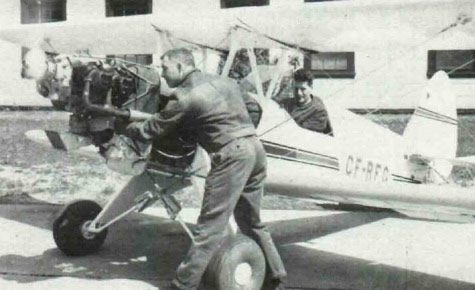More on That EAA Biplane CF-RFG
We mentioned the EAA CF-106 Biplane CF-RFG in last month’s Bits and Pieces (incorrectly identified as RFC in that article). It became obvious that the designation “CF-106” was a tongue-in-cheek name since both builders had worked on the CF-105 Avro Arrow project before it was canceled. The CF-106 was their next project! Gord McNulty was kind enough to send us this update on both builders and the aircraft itself. – Editor
June 2015 - Russ Norman, co-builder of the aircraft with the late George Ellis, lives in Hamilton, Ontario. He’s 87 and his health isn’t good. I wrote a full-length article on Russ, published in the spring 2003 edition of the Canadian Aviation Historical Society Journal, Vol. 41, No. 1, under the title “Russ Norman: A Dedicated Proponent of Canadian Homebuilt Aviation”.
Russ was highly active in the EAA for many years, a key leader of EAA Chapter 65 in Hamilton. He attended the EAA fly-in convention for more than 50 years, starting in 1958. Russ started RFG with George, a fellow Avro Canada employee, in 1957. It took five-and-a-half years to complete, at a cost of $1,700 including engine and prop. It was the first EAA Biplane built and flown in Canada. Russ and George enjoyed many hours flying the aircraft. Paul Poberezny flew it once for two or three circuits at Mount Hope. My notes show the aircraft was underpowered with a 65-hp Continental engine, which was replaced with an 85-hp powerplant.
The Biplane was sold to a man in Boston, who took it to the United States and proceeded to crash it on its first flight. Russ doesn’t recall what became of it. George Ellis died quite some time ago. Russ lost his job at Avro with the cancellation of the Arrow, then worked for 25 years at the Hamilton Board of Education until retiring in 1993. In 1965, Russ started his next homebuilt, a Corben Junior Ace, which became the new CF-RFG. He eventually sold the Junior Ace to start his third homebuilt, a sleek high-performance Mustang II, C-GFEL. He finished it 23 years later in 2000 and first flew it in 2001. There wasn’t any push to finish it as Russ had the Junior Ace to fly as well as a Steen Skybolt, C-GNST, built by his son, Vaughan.
In recent years, Russ has been restoring a vintage Dart Model G, CF-SUS, at Brantford. It was No. 4 on the production line of the Dart Manufacturing Co. in Columbus, Ohio. This aircraft was owned by collector Ralph Howling of Harrow in southwestern Ontario. Howling’s files show that his Dart was demonstrated at the Miami air races circa 1938. One of the previous owners was Robert Wagner, an aerobatic pilot from Dayton, Ohio. Wagner, now in his 80s, was still doing test flying for the new Waco Classic Aircraft Corporation (as of 2013 at least) and was awarded the Wright Brothers Master Pilot award from the FAA in 2009.
The Dart, designed by the famous Al Mooney, became known as the Culver Dart and is probably best known as the precursor to the Culver Cadet. It was a nifty monoplane, with two seats side-by-side and an open cockpit. It had a wide, elliptical wing and was fully aerobatic. While production was very modest, it had many admirers who liked its good looks and sporty appeal.

